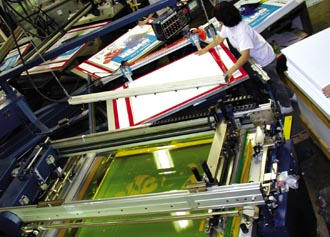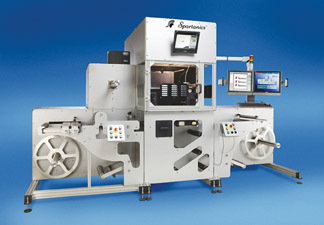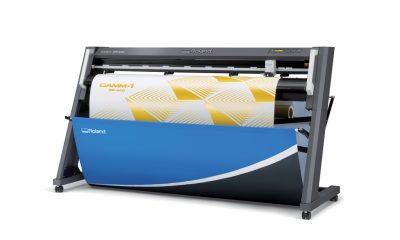Graphics Printing
Published
21 years agoon

To an outsider, screen-printing technology must appear as the perfect Rube Goldberg process. With screen printing, the simple task of "stenciling" a design onto a surface somehow turns into a ridiculously complex procedure that requires fabrics with a dozen physical and processing parameters and screen frames with various profiles and strengths. The process needs stencil materials that come in the form of coatings or films that are directly or indirectly applied to the mesh and have numerous physical and photochemical properties.
To an outsider, screen-printing technology must appear as the perfect Rube Goldberg process. With screen printing, the simple task of "stenciling" a design onto a surface somehow turns into a ridiculously complex procedure that requires fabrics with a dozen physical and processing parameters and screen frames with various profiles and strengths. The process needs stencil materials that come in the form of coatings or films that are directly or indirectly applied to the mesh and have numerous physical and photochemical properties. It requires squeegees with dozens of parameters and inks with specific rheological and finished characteristics that are compatible with the substrate, as well as the printing process. Add to this the variety of printing equipment and the slew of ancillary pre- and post-press machines and gadgets used today, and we have the perfect subject for an industrial cartoon. Unlike some of the printing processes developed in the latter half of the 20th century, screen printing did not have a "blue print" to follow in order to mature into a smooth, sophisticated technology. The simplicity of its goal–transferring ink in the form of a specific image–was often blurred by additional requirements to handle a wide variety of substrates, surfaces, and shapes. The process also suffered from a piecemeal correction of technical problems that often led to new problems that had to be corrected ad infinitum. Any engineer who takes a look at the process today cannot help but wonder, "Why are we doing this? There’s got to be an easier way!" Perhaps this was the question that prompted Prof. Steven Abbott to examine the squeegee’s contribution to the screen-printing process and conclude that the process would be better off without the squeegee ("Confessions of a Squeegee Heretic," Screen Process, Nov. 2002, page 18). What struck me most about his discussion was his statement that "it’s easy to screen print without a squeegee." He proceeded to explain that while printing without a squeegee is "not a practical method," all we really need is a "scraping device" that does not participate in the printing process. Excuse me? What is a squeegee if not a scraping device? And how could it not participate in printing once it ends up in the middle of the screen? Far from ideal The squeegee (Figure 1) is by no means an ideally simple component in the screen-printing process. But neither is the screen/stencil printing plate. Ideal mesh threads would be infinitely thin in the horizontal direction and adjustably thick vertically. This way, threads would stop interfering with image edges and would allow for specific ink-thickness deposits. The ideal screen would also be able to release all the ink it contains. Of course, a mesh with these characteristics would not be practical because, first, there is no infinitely thin material in one direction only, especially one strong enough to tension. Second, if the material were inert enough to release all the ink (like Teflon) we could not adhere a stencil to it. Looking only at the stencil, the ideal stencil would be one in which thickness could be controlled with sub-micron accuracy. It would have an absolutely flat print-side surface with an Rz value that ensures perfect gasketing around the image and still allows for the release of the stencil from the substrate (minimum vacuum effect). It would also have a resolution that is comparable to photographic films. To the best of my knowledge, no such stencil exists. I could list most screen-printing materials and printing components and find similar discrepancies between what is ideal and what is practical. Abbot is not the first to complain about all the problems the squeegee causes in screen printing. In fact, I summarized the situation 19 years ago, when I wrote that "the ideal squeegee–as any screen printer would agree–is no squeegee at all." (See "Linear, Multipoint, Polymer Pressure Activator: Introducing the Squeegee," Screen Printing, April 1984, page 100). Since then, dozens of technical articles have been written in various publications that expound one theory or another and explain why the squeegee is a wonderful tool or a necessary evil. At least half a dozen different US patents exist for screen-printing methods and equipment that tried–mostly through the use of vacuum–to eliminate the need for squeegees in screen printing. Some of the articles and patents are listed in the bibliography at the end of this article. To the best of my knowledge, there are only two or three squeegeeless printing methods in use today. One is used in electronics to fill via-holes in circuit boards and the other is the Hix cap printer for textile-based materials. Both of these methods use vacuum to print (although the electronics printer also uses a "scraper"). The third method is an experimental electrostatic deposition of powders through a screen (a proprietary and not well-known process). All the rest of the squeegeeless printing methods have quickly faded into obscurity after their initial novelty period. The real question printers should be asking is, "Why haven’t we found a replacement for squeegees after 30 or more years of searching?" If screen printing were used solely as a graphic arts process printing on, let’s say, porous flexible sheet materials only, every press today would be a vacuum-printing press. Alas, no such uniformity exists for screen-printed products. Although graphic arts is the major market for screen printing, the substrates used in the process include paper, wood, textiles, polymers, metals, glass, and even food items. The designs themselves break down to halftones, line art, surface coatings, and functional designs (e.g., electrical conductors, gaskets, etc.). Because each of the substrates and each of the designs require a different ink (chemistry) to fulfill the print’s purpose, the printing process must be modified to match these requirements. As rational as it might seem to eliminate the squeegee from the process, the fact that screen printing is not solely a graphic-arts process used on a narrow range of substrates puts squeegeeless printing into the same class of technology as personal antigravity flying machines. For the last hundred years, the screen-printing industry had choices to make. Should the manufacturers of equipment and inks develop product-specific tools that would enhance specialization or should they make universally applicable products that can be modified for different requirements? Given the size of the industry and the variety of decorating markets it serves, both manufacturers and printers chose the latter. What gave the squeegee such prominence in screen printing was the universality it imparted to the process. Yes, certain things could be done better without a squeegee. But with it, all decorating problems could be solved with some degree of success. While a certain amount of specialization did develop in screen printing (e.g., industrial vs. graphic arts, textile vs. electronics), the elements of the process that connected all these applications were the screen and, especially, the squeegee. So, how does the squeegee accomplish this incredible feat that apparently no squeegeeless process can? To transfer a stencil image to a substrate, we need a method to fill a stencil with ink and a method to bring the stencil into intimate contact with the substrate. Vacuum printing processes accomplish this by simply keeping a lot of highly viscous ink on top of the screen and evacuating air below the substrate to bring the ink through the screen and onto the material. Unfortunately, to achieve a uniform image using this method, the substrate must be porous and the ink must have very precise rheological properties. These two requirements alone would leave 80-90% of screen-printed products unprintable. However, with a squeegee, we can–in a single step–fill the stencil with ink, remove the excess ink, and bring the screen into contact with the substrate just long enough for ink-transfer to occur. There are no special requirements for substrate porosity, size, and surface uniformity, and ink rheology becomes a lot less critical. Of course, this universal printing capability of the squeegee comes at a price; namely, everything the squeegee is and does affects the print. Even if there were only a few squeegee parameters (there are probably more than a dozen), the way these parameters interact with the ink and the screen creates a complex system that is difficult, but not impossible, to understand. Today we know significantly more about the screen-printing process than we did even 25 years ago. Significant advances were made in mesh, stencil, and ink technologies, and the manufacturers of these products made sure that we knew about them. Similar advances were also made in squeegee technology, but these advances did not seem as important simply because the squeegee was never considered an integral part of the process. For some reason, the squeegee is always assumed to be part of a printing press not of the printing process. Normally, a considerable amount of forethought and design go into the preparation of screens and stencils because everyone agrees that they determine the success of printing. Squeegees, on the other hand, are an afterthought: "Oh yeah, we’ll also need a squeegee to print." To demonstrate how much the squeegee is an integral part of the printing process, we can perform a small "thought experiment." First of all, we must remember that the squeegee has a number of physical and dynamic attributes that cannot help but affect the printing process. The most important of these are listed in Table 1. The significant thing about this list is not how many items appear on it, but how they are related. If we have to use a squeegee–and I do not see how we can avoid it–these are the simple physical rules that determine how our squeegee is going to act. The decision we have to make is whether to completely ignore them or study them and make them part of our printing process.
,br> Table 1 Relationship between physical and dynamic squeegee characteristics
Dynamic characteristics Physical characteristics Speed Pressure Angle Durometer Durometer affects printing speed: The harder the durometer the greater the speed. Pressure and durometer modify printing angle. Durometer controls the printing angle relative to speed and pressure. Length Length and speed are inversely proportional in terms of printing controls: The longer the squeegee, the slower the speed for the same level of control. The greater the length, the less uniform the pressure along the entire length. The greater the length, the less uniform the printing angle along the entire length. Thickness Thickness moderates the effects of durometer (see durometer above). Thickness moderates the effects of durometer (see durometer above). Thickness moderates the effects of durometer (see durometer above). Free height Free height and speed are inversely proportional for any given durometer, pressure, and angle: The larger the free-height, the slower the speed. Free-height and pressure are inversely proportional for any given durometer, speed, and angle: The greater the free-height, the smaller the pressure. Free-height and angle are inversely proportional for any given durometer, speed and pressure: The greater the free height, the smaller the angle. Profile Thinner profile reduces the effective durometer near the printing edge (see durometer above). Thinner profile reduces the effective durometer near the printing edge (see durometer above). Thinner profile reduces the effective durometer near the printing edge (see durometer above). Printing edge Printing edge sharpness and speed are directly proportional if all other parameters are the same: The sharper the edge, the greater the allowable speed. Printing edge sharpness and pressure are indirectly proportional if all other parameters are the same: The sharper the edge, the smaller the required pressure. If all other parameters are the same, edge sharpness and angle do not affect one another. Chemical resistance Chemical resistance and speed, in conjunction with ink, determine how long the printing edge lasts. Chemical resistance and pressure, in conjunction with ink, determine the extent of permanent deformation of the blade under pressure. Chemical resistance and angle do not affect one another. Abrasion resistance Abrasion resistance and speed, in conjunction with ink, determine how long the printing edge lasts. Abrasion resistance and pressure do not affect one another. Abrasion resistance and angle do not affect one another. The physical and dynamic squeegee characteristics affect image quality and production yield. Since experience has shown us that it is possible to achieve a perfect print with a squeegee, let’s make a generalized statement: For any given screen tension, off-contact distance, and ink rheology, there is only one set of perfectly adjusted squeegee parameters that will give perfect results. For the purposes of this experiment, it is not important how we achieve this perfect squeegee setup. What we are looking for is what happens if we deviate from this perfectly adjusted setup. What happens if we change one or both the physical and dynamic characteristics of the squeegee? If the squeegee is unimportant, we will find a number ways to print without affecting the quality and production yield of the process. If, on the other hand, the squeegee is an important part of the process, then any change in setup will affect quality and/or production yield. Given what we know about the interaction of squeegee screen and ink, some of these effects are listed in Table 2. Note that Table 2 is significantly abbreviated for the sake of clarity and simplicity. Only six of the most important physical and dynamic characteristics from Table 1 are listed (durometer, free height, printing edge, speed, pressure, and angle), and only one third of the possible permutations of these characteristics are given. (For example, under durometer and speed, only the increase or decrease of both are listed. There are four more possibilities where one is increased and the other is decreased or left unchanged. If you are interested, you can work out the rest for yourself, but I guarantee that it will make no difference for this thought experiment.) The most striking observation you can make about Table 2 is that, as far as the squeegee is concerned, screen printing is not as forgiving as most people maintain. First of all, deviating from the "perfect" squeegee setup guarantees that you will reduce your production yield 83% of the time, and for the remaining 17%, you might increase the yield at a significant risk to quality. In terms of overall quality (correct ink deposit, resolution, and acutance), changing the perfect squeegee setup results in reduced quality about 80% of the time. If this is not a vindication of the importance of the squeegee in the process of screen printing, then I don’t know what is.
Table 2 Relationship between squeegee characteristics, image quality, and production
Effects on Image Quality and Production Changing squeegee characteristics Ink-thickness requirement Image resolution and acutance Production yield Change durometer and increase speed Less ink Missing elements or no effect Higher but risky decrease speed No effect Smearing Lower increase pressure More ink Smearing or no effect Lower or no effect decrease pressure More ink or no print Smearing Lower increase angle Less ink No effect Lower or no effect decrease angle More ink Smearing Lower Change free height and increase speed More ink Possible smearing Higher but risky decrease speed Less ink or no effect No effect Lower increase pressure More ink Smearing Lower decrease pressure More ink or no effect Smearing or no effect Lower or no effect increase angle More ink or no effect Smearing or no effect Lower or no effect decrease angle More ink Smearing or no effect Lower or no effect Change printing edge and increase speed Less ink Missing elements or no effect Higher but risky decrease speed More ink Smearing or no effect Lower or no effect increase pressure Less ink or no effect No effect Lower or no effect decrease pressure More ink or no print Smearing Lower increase angle Less ink Missing elements or no effect Lower or no effect decrease angle More ink Smearing Lower Whether or not you like using a squeegee, you are stuck with it. It is the single most important processing parameter beside the screen/stencil system. Because, at the present, squeegeeless printing is not an option, at least in the "universal applicability" sense, the best we can do is find ways to use the squeegee better and strive for that elusive "perfect squeegee setup." Perhaps the time has also arrived to seriously contemplate developing product-specific squeegeeless screen-printing systems where or whenever such systems are appropriate. In any case, just complaining about the squeegee is an exercise in futility. Screen-printing companies must make a choice. They can ignore the squeegee and suffer the consequences, or they can learn as much as possible about the purpose and use of the squeegee, then profit from their knowledge.

Subscribe

Magazine
Get the most important news
and business ideas from Screenprinting Magazine.
Most Popular
-

 Art, Ad, or Alchemy1 month ago
Art, Ad, or Alchemy1 month agoF&I Printing Is Everywhere!
-

 Case Studies1 month ago
Case Studies1 month agoHigh-Density Inks Help Specialty Printing Take Center Stage
-

 Andy MacDougall1 month ago
Andy MacDougall1 month agoFunctional and Industrial Printing is EVERYWHERE!
-

 Columns2 weeks ago
Columns2 weeks ago8 Marketing Mistakes Not to Make When Promoting Your Screen Printing Services Online
-

 Editor's Note2 weeks ago
Editor's Note2 weeks agoLivin’ the High Life
-

 Thomas Trimingham2 months ago
Thomas Trimingham2 months ago“Magic” Marketing for Screen Printing Shops
-

 Marshall Atkinson2 weeks ago
Marshall Atkinson2 weeks agoHow to Create a Winning Culture in Your Screen-Printing Business
-

 News & Trends1 month ago
News & Trends1 month agoWhat Are ZALPHAS and How Can You Serve Them in Your Print Business?






